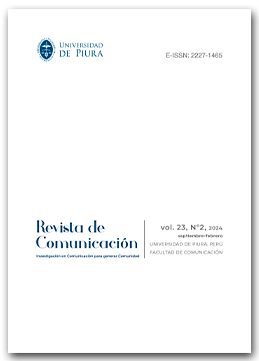The narrative of success. The strategy of humanization in neoliberal film creation
DOI:
https://doi.org/10.26441/RC23.2-2024-3556Keywords:
neoliberalism, affective turn, capitalism, cinema, film analysis, narrative, successAbstract
This paper aims to analyze several specific forms of filmmaking very related to neoliberalism as an economic, political and cultural system, taking as reference the affective turn to explore this link. For this, it will be considered the different contributions that, from different fields of social sciences, have linked the evolution of capitalism with the conquest of the sphere of affections and emotions, and it will use the methodology of film analysis to verify, in a set of concrete works, the features of that relationship. From this intersection between theoretical proposals and case analysis, the article wants to show an expressive strategy based on the humanization of certain behaviors, through the cinematographic narrative, which normalizes some attitudes and values due to decisions which work on the construction of the story an the aesthetics of the work. This strategy will be verified in three very significant films: The Social Network, Steve Jobs and The Founder.
Metrics
References
Ahmed, S. (2019). La promesa de la felicidad: una crítica cultural al imperativo de la alegría. Caja Negra.
Alonso, L. (2010). Lenguaje del cine, praxis del filme. Plaza y Valdés.
Arias Maldonado, M. (2016). La democracia sentimental: política y emociones en el siglo XXI. Página Indómita.
Aumont, J. & Marie, M. (2019). El análisis cinematográfico. La Marca Editora.
Barthes, R. (2009). La aventura semiológica. Paidós.
Berlant, L. (2020). El optimismo cruel. Caja Negra.
Boltanski, L. & Chiapello, È. (2002). El nuevo espíritu del capitalismo. Akal.
Brinkema, E. (2014). The forms of the affects. Duke University Press. https://doi.org/10.1515/9780822376774 DOI: https://doi.org/10.1515/9780822376774
Burch, N. (2011). El tragaluz del infinito. Cátedra.
Carmona, R. (2010). Cómo se comenta un texto fílmico. Cátedra.
Casetti, F. & Di Chio, F. (2017). Cómo analizar un film. Paidós.
Català Domenech, J. (2001). La puesta en imágenes: conceptos de dirección cinematográfica. Paidós.
Chatman, S. (2013). Historia y discurso: la estructura narrativa en la novela y en el cine. RBA.
Davies, W. (2016). La industria de la felicidad: cómo el gobierno y las grandes empresas nos vendieron el bienestar. Malpaso.
Deleuze, G. (1987). La imagen-tiempo: estudios sobre cine 2. Paidós.
Depetris Chauvin, I. y Taccetta, N. (2017). Giro afectivo y artes visuales. Una aproximación interdisciplinaria sobre América Latina. Imagofagia, 16, 357-370.
Eco, U. (2013). Los límites de la interpretación. Debolsillo.
Ehrenreich, B. (2019). Sonríe o muere: la trampa del pensamiento positivo. Turner.
Enciso Domínguez, G. y Lara, A. (2014). Emociones y ciencias sociales en el siglo XX: la precuela del giro afectivo. Athenea Digital, 14(1), 263-288. http://dx.doi.org/10.5565/rev/athenead/v14n1.1094 DOI: https://doi.org/10.5565/rev/athenead/v14n1.1094
Fernández Porta, E. (2012). €®0$: la superproducción de los afectos. Anagrama.
García, A.N. (ed.) (2016). Emotions in Contemporary TV Series. Palgrave Macmillan. https://doi.org/10.1007/978-1-137-56885-4 DOI: https://doi.org/10.1007/978-1-137-56885-4
Habermas, J. (1981). Historia y crítica de la opinión pública: la transformación estructural de la vida pública. Gustavo Gili.
Han, B. (2021). Psicopolítica: neoliberalismo y nuevas técnicas de poder. Herder.
Lara, A. y Enciso Domínguez, G. (2013). El Giro Afectivo. Athenea Digital, 13(3), 101-119. https://doi.org/10.5565/rev/athenead/v13n3.1060 DOI: https://doi.org/10.5565/rev/athenead/v13n3.1060
Lünenborg, M. y Maier, T. (2018). The turn to affect and emotion in Media Studies. Media and Communication, 6(3), 1-4. https://doi.org/10.17645/mac.v6i3.1732 DOI: https://doi.org/10.17645/mac.v6i3.1732
Marzal, J. & Gómez Tarín, F. (2007). Metodologías de análisis del film. Edipo.
Metz, C. (2002). Ensayos sobre la significación en el cine (vols. 1 y 2). Paidós.
Mould, O. (2019). Contra la creatividad: capitalismo y domesticación del talento. Alfabeto.
Pardo, J. (2017). Estudios del malestar: políticas de la autenticidad en las sociedades contemporáneas. Anagrama.
Podalsky, L. (2011). The Politics of Affect and Emotion in Contemporary Latin American Cinema: Argentina, Brazil, Cuba, and Mexico. Palgrave Macmillan. https://doi.org/10.1057/9780230120112 DOI: https://doi.org/10.1057/9780230120112
Polanyi, K. (2016). La gran transformación: crítica del liberalismo económico. Virus.
Santamaría, A. (2018). En los límites de lo posible: política, cultura y capitalismo afectivo. Akal.
Sennett, R. (2019). La corrosión del carácter: las consecuencias personales del trabajo en el nuevo capitalismo. Anagrama.
Taccetta, N. (2018). La sublevación y sus gestos. Imaginación, aura y despertar como figuraciones de la crítica. Recial, 14 (24), 43-61. https://doi.org/10.53971/2718.658x.v15.n24.43329 DOI: https://doi.org/10.53971/2718.658x.v15.n24.43329
Ticineto Clough, P. (ed.) (2007). The Affective Turn: Theorizing the Social.Duke University Press. https://doi.org/10.2307/j.ctv11316pw DOI: https://doi.org/10.2307/j.ctv11316pw
Zafra, R. (2017). El entusiasmo: precariedad y trabajo creativo en la era digital. Anagrama.
Zumalde, I. (2011). La experiencia fílmica: cine, pensamiento y emoción. Cátedra.
Zunzunegui, S. (1995). La mirada cercana: microanálisis fílmico. Paidós.
Referencias audiovisuales
Boyle, D. (Director). (2015). Steve Jobs [Película]. Legendary Pictures; Scott Rudin Productions; Mark Gordon Company; Entertainment 360; Decibel Films; Cloud Eight Films.
Fincher, D. (Director). (2010). La red social [Película]. Michael De Luca Productions; Scott Rudin Productions; Trigger Street Productions.
Hancock, J. (Director). (2016). El fundador [Película]. FilmNation Entertainment.
McKay, A. (Director). (2015). La gran apuesta [Película]. Paramount Pictures; Regency Enterprises; Plan B Entertainment.
McKay, A. (Director). (2018). Vice [Película]. Annapurna Pictures; Plan B Entertainment; Gary Sanchez Productions.
McKay, A. (Director). (2021). No mires arriba [Película]. Hyperobject Industries; Bluegrass Films.
Reitman, J. (Director). (2005). Gracias por fumar [Película]. Room 9 Entertainment; ContentFilm.
Reitman, J. (Director). (2009). Up in the air [Película]. DreamWorks Pictures.
Sorkin, A. (Director). (2020). El juicio de los 7 de Chicago [Película]. DreamWorks Pictures.
Sorkin, A., Schlamme, T. y Wells, J. (Productores ejecutivos). (1999-2006). El Ala Oeste de la Casa Blanca [Serie de televisión]. Warner Bros. Television.
Downloads
Published
How to Cite
Issue
Section
License
Copyright (c) 2024 Revista de Comunicación

This work is licensed under a Creative Commons Attribution-NonCommercial-NoDerivatives 4.0 International License.












 Portal de Revistas de la Universidad de Piura.
Portal de Revistas de la Universidad de Piura.